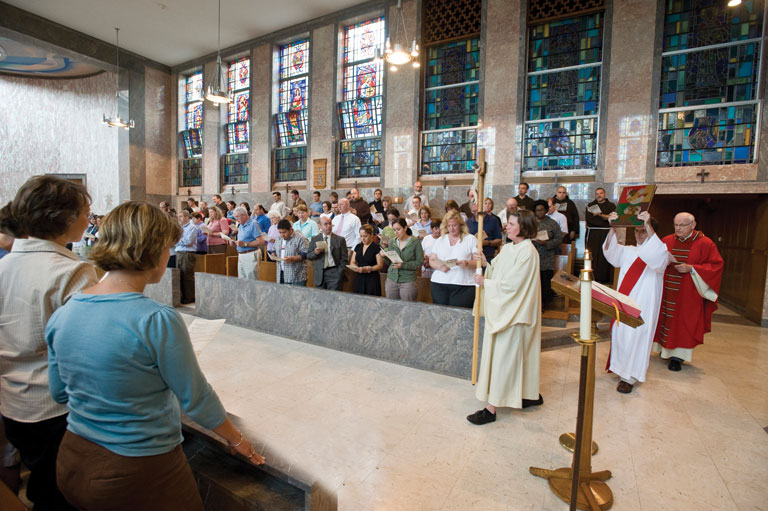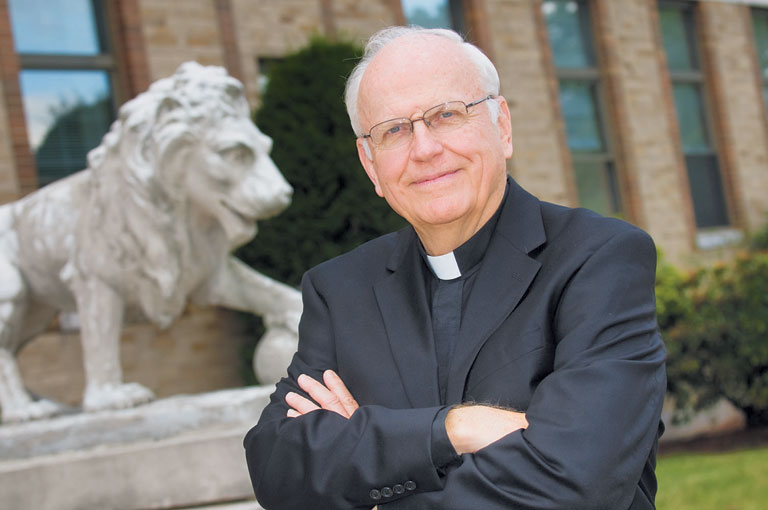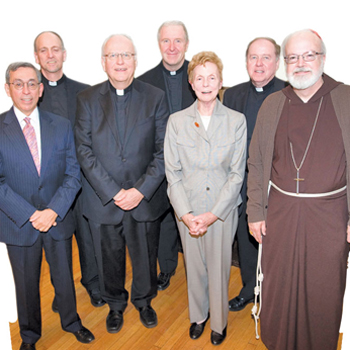The word had spread for several years that a "merger" was in the works between Boston College and Weston Jesuit School of Theology. And there was some truth to the rumor—beginning in 2004, something big was being planned between the 14,600-student Jesuit university in Chestnut Hill, Massachusetts, and the 189-student Jesuit theological school, located across the Charles River in Cambridge. That work came to maturity on June 1, 2008, when Weston ceased to exist as an independent school.
But the record must be corrected from the start: This has not been a true merger but a reaffiliation — after all, Weston's graduates received Boston College degrees from 1959 to 1974. The reaffiliation has brought Weston back into the Boston College fold by incorporating it, along with the university's Institute of Religious Education and Pastoral Ministry (IREPM), into a new School of Theology and Ministry.
 |
| The beginning of the new School of Theology and Ministry was marked by an inaugural Mass on November 4, 2008 |
The reaffiliation required four years, which included reams of documentation that showed that the Jesuits were following church regulations and civil law. The result is that the new School of Theology and Ministry is a professional school of Boston College, joining the university's other graduate-level schools of law, education, nursing, management, and social work. And, it has retained the full accreditation that the Association of Theological Schools first granted to Weston in 1968, with its next accreditation visit scheduled for 2010. It should be noted that Boston College retains its separate theology department, which serves both undergraduate and graduate students and remains within the School of Arts and Sciences.
Two distinct departments, but operating as one
Boston College's president, Jesuit Father William P. Leahy, describes the organizational structure of the new School of Theology and Ministry as two departments—the Weston Jesuit Department and the Institute of Religious Education and Pastoral Ministry—within a single school and operating as a single faculty. The Weston Jesuit Department remains an ecclesiastical faculty, just as the independent Weston Jesuit School of Theology was. As an ecclesiastical faculty, the Weston Jesuit Department is authorized by the Vatican Congregation for Catholic Education to award bachelor's, licentiate, and doctoral degrees in sacred theology. So, the School of Theology and Ministry's civil degrees, like the M.Div., are granted by Boston College by virtue of the university's Massachusetts charter, while its ecclesiastical degrees are granted by the ecclesiastical faculty as authorized by the Congregation for Catholic Education in Rome. (A noncredit program in religion and spirituality—begun in 2004 and called "C21 Online"—is also located within the new graduate school.)
Further evidence of the distinction: Members of the ecclesiastical faculty are legally separate from the Boston College faculty and are not employees of the university. Instead, their hiring, promotion, and tenuring fall under statutes based upon the apostolic constitution "Sapientia Christiana," the 1979 Vatican document that governs ecclesiastical faculties worldwide. In other respects, however, ecclesiastical faculty members are like university faculty and enjoy similar benefits and salary levels. Faculty who were affiliated with the former IREPM remain covered by Boston College statutes. Moreover, administrators and staff of the School of Theology and Ministry are university employees and subject to all of the university's human resources policies. This two-fold nature of the school leads the school's dean, Jesuit Father Richard J. Clifford, to describe himself as having dual responsibility—to Boston College and to Rome.
Oversight of the new school
The new school has a two-tier governance structure. In one of the tiers, Boston College has ultimate authority over everything pertaining to civil law and related matters—capital and operating budgets, legal officers, tuition rates, fundraising and construction, and the acquisition, control, and disposal of assets. The other tier consists of a board of directors with 15 to 21 members. One of these is the head of the U.S. Jesuit Conference. Ten more are the leaders of the 10 Jesuit provinces in the United States (or their delegates). The other members are chosen by Boston College and come from the ranks of the university's faculty and administration.
In addition, an advisory board meets twice yearly to oversee and promote the school's development efforts.
Like other professional schools of the university, the School of Theology and Ministry also has an academic council, composed of all of the school's full-time faculty and the dean. The president of the academic council serves on the school's executive committee, along with the dean, the associate dean for academic affairs, the two department chairs, and two elected faculty (one from each department). President Leahy describes the two bodies — academic council and executive committee — as interdependent and complementary, intended to provide appropriate venues for discussion of pertinent issues, to offer advice and recommendations to the dean, and to promote shared responsibility for the operations of the School of Theology and Ministry.
Combining strengths, avoiding rivalries
Father Leahy says that the first, tentative conversations about strengthening the connection between Boston College and Weston Jesuit School of Theology began in the 1990s. Jesuit Father Donald Monan, the former president of Boston College, wanted the university and the seminary to make better use of their resources in a collaborative way, especially as both were preparing leaders for the church. In 1996-97, a grant from the Teagle Foundation enabled the schools to begin planning for the reaffiliation. One of the big issues, of course, was the geographic separation—four miles can seem like a long distance in traffic-choked Boston.
After Boston College bought 88 acres from the Archdiocese in Boston—a process that began in 2004—reaffiliation began to look like a real possibility. The new property, located in the town of Brighton but immediately adjacent to Boston College's main campus in Chestnut Hill, already houses St. John's Seminary, which trains priests for the Boston archdiocese and other dioceses. And the libraries of Weston and St. John's have merged into a single collection of 250,000 volumes, although St. John's retains ownership of its own books.
By August of this year, the classrooms and office of the School of Theology and Ministry will have moved into a newly renovated building. Members of the school's Jesuit community—both students and faculty who belong to the Society of Jesus—are still waiting for new housing to be built for them; they will remain separate from Boston College's Jesuit community on the other side of the university's campus in St. Mary's Hall.
 |
| Jesuit Father Richard J. Clifford, dean of the new School of Theology and Ministry. |
Father Clifford, the dean, notes the complementary strengths that the two reaffiliating institutions brought to the combined school. Preparation for the priesthood had loomed large at the old Weston campus, even though there were many lay students. Meanwhile, the IREPM's few ordained students were vastly outnumbered by lay women and men. Each school had strengths in different disciplines, too. Weston had offered a broad array of theology courses, plus church history, Bible, systematic theology, pastoral theology and practice, and ethics. But at Boston College, IREPM had had a distinct approach to theology and concentrated on religious education and adult and youth faith formation.
Father Leahy shares credit for the reaffiliation with the former president of Weston, Jesuit Father Robert E. Manning, who died in 2008. Leahy describes how he and Manning began negotiating the reaffiliation, not as rivals, but as fellow workers toward a common mission of service to the Catholic Church. "We knew that everyone gains with sharing of resources."
Weston's 18 professors, plus the school's fine theological library, add a significant strength to Boston College. And Father Leahy says that Weston's 220 students are already affecting campus life at the university — including leading retreats, getting involved with student organizations on campus, and working with international students.
Outside relationships
The move from Cambridge to Boston College was Weston's second move in 80 years. Founded as a college in 1922, with a theology faculty added in 1927, the school of theology was located in the Boston suburb of Weston for its first 40 years, where it focused on educating men for ordination as Jesuit priests. But when the school moved to the ivy-covered precincts of Harvard University in 1968, its faculty and student body began welcoming lay students, and the school built a special relationship with both Harvard Divinity School and nearby Episcopal Divinity School. It also had access to the Boston Theological Institute (BTI), a consortium of nine seminaries.
The reaffiliation has not altered this advantageous arrangement with the Boston Theological Institute, which grants students access to 1.5 million volumes in the libraries of the participating schools. Students may also cross-register in any of the member institutions for no additional tuition charges, allowing an inexhaustible number of possibilities for academic courses and programs.
Concerns and losses
Leahy admits that getting used to the idea of change was difficult for some Weston faculty, students and alumni. Some were concerned that Weston's identity would be lost. But others were pleased to be affiliated with Boston College. Leahy says that he communicated regularly with alumni to address their concerns. Through the reaffiliation process, he can share some lessons about communication:
-
Name the issues early.
-
Define the issues pertaining to people, the academic offerings, the organizational structure and finances, and the culture.
-
Put your best minds to work on all these issues.
When asked about any downsides to the reaffiliation, both Leahy and Clifford acknowledge that leaders of both Weston and IREPM had concerns about what they might lose. "It is natural that there would be fears," says Father Clifford. But in some cases, what each side saw as its unique strengths were revealed to be strengths in common. For example, both were proud of their tailored approach to student needs and abilities. Both saw their academic culture as informal. Both appreciated a sense of autonomy.
On the other hand, there were real differences between the schools, and real losses that resulted from the reaffiliation. For example, the liturgical life that is the centerpiece of Catholic formation was different at each school. Governance at IREPM was more informal than at Weston. And Weston lost its connection to the Episcopal Divinity School, with which it had shared a library. And of course, it left Harvard Yard back in Cambridge—and the rich possibilities of sharing a hometown with America's oldest and wealthiest university.
 |
| Among those who attended the November 2008 ceremonies marking the beginning of the new school were (from left) Cutberto Garza (provost of Boston College), Father Thomas Smolich (president of the U.S. Jesuit Conference), Father Richard J. Clifford (dean of the School of Theology and Ministry), Father Bradley Schaeffer (rector of the Weston Jesuit Community), Jill Ker Conway (former president of Smith College), Father William P. Leahy (president of Boston College), and Cardinal Seán O’Malley (Archbishop of Boston). |
Moving forward with shared values
In the Fall 2008 issue of Boston College Magazine, Father Clifford summarized the key elements of the new school:
■ Its mission. The fostering of Christian faith and the promotion of justice and reconciliation.
■ Its students. Jesuits and other candidates approved for ordination studies, women and men for lay ecclesial ministries and for service rooted in faith.
■ Its commitments. The Catholic theological tradition, rigorous academic inquiry, interdisciplinary study, ecumenical and interreligious dialogue, and the engagement of faith and culture—and, permeating these, a commitment also to forming a community that is contemplative, critical, and collaborative.
■ Its inspiration. The Ignatian tradition [that is, the form of Catholic spirituality that is particular to the Jesuits, the religious movement founded by St. Ignatius Loyola].
Given that two previously separate institutions are learning to operate as one faculty—and given the new school's ambitious mission statement—four years to plan and implement a reaffiliation is perhaps not such a long time after all.